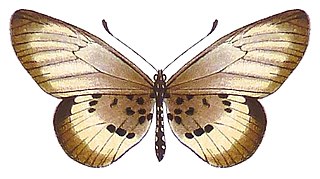
Arhopala abseus, the aberrant oakblue or aberrant bushblue, is a species of lycaenid or blue butterfly found in Asia.
The crow tiger is a species of nymphalid butterfly in the Danainae subfamily. It is endemic to the Solomon Islands.

Oedemera is a genus of beetles of the family Oedemeridae, subfamily Oedemerinae.

Leptostylopsis annulipes is a species of longhorn beetles of the subfamily Lamiinae.

Euphaedra neophron, or the gold banded forester, is a butterfly of the family Nymphalidae. It is found in eastern and southern Africa.

Acraea peneleos, the Peneleos acraea, is a butterfly in the family Nymphalidae, which is native to the tropics and northern subtropics of sub-Saharan Africa.
Euphaedra wissmanni is a butterfly in the family Nymphalidae. It is found in the southern part of the Democratic Republic of the Congo.

Dermestes ater is a species of beetle in the family Dermestidae, the skin beetles. It is known commonly as the black larder beetle or incinerator beetle. It is native to North America, but today it is found nearly worldwide. Like several other dermestid beetles, this species is a common pest of stored products.

Chilocorus nigritus, sometimes referred to as the Malaysian ladybird beetle, is a species of lady beetle in the family Coccinellidae. It is native to SE Asia, but has been introduced for use in biological pest control in Hawaii and many parts of the world, including Europe.
Anthrenus ceylonicus, is a species of skin beetle found in Sri Lanka.
Orphinus guernei is a species of skin beetle found in Sri Lanka.
Thaumaglossa tonkinea, is a species of skin beetle found in Malaysia, Singapore, Thailand, Vietnam, China, Taiwan and probably Sri Lanka.

Thaumaglossa pici, is a species of skin beetle found in Sri Lanka.
Tanymecus curviscapus, is a species of weevil found in India and Sri Lanka.
Episomus figuratus is a species of weevil found in Sri Lanka.
Myllocerus curvicornis, commonly known as coconut ash weevil, is a species of weevil found in India and Sri Lanka.
Jauravia soror, is a species of lady beetle native to India, and Sri Lanka.
Decellebruchus walkeri is a species of leaf beetle found in India, Kenya, Sri Lanka and Thailand.
Holostrophus toyoshimai is a species of polypore fungus beetle in the family Tetratomidae. Being identified in 2017 by Masahiro Saitȏ and Ondřej Konvička, Holostrophus toyoshimai was identified upon the discovery of five specimens located within central Honshu to which they were identified as a new species.

Litocerus plagiatus is a weevil in the genus Litocerus, which contains other weevil species with similar morphological traits. This weevil is characterized by its distinctive yellow-ochreous and black patterns, red hues, and lack of a tubercle on its abdomen.








